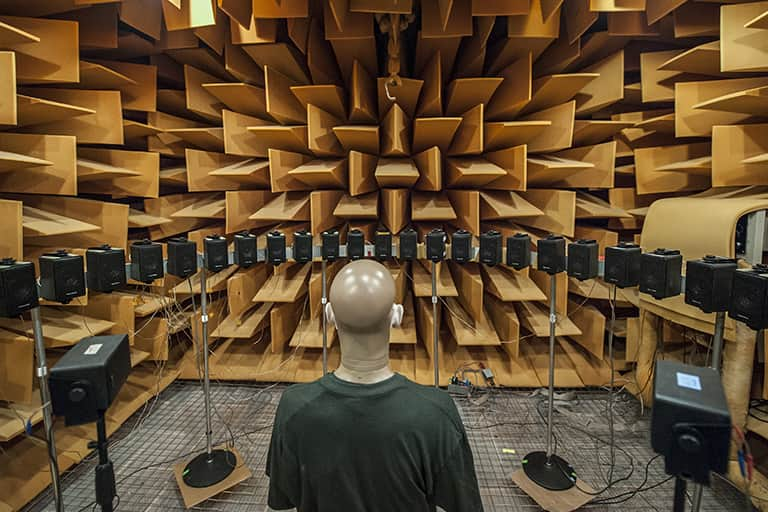Designing a sound laboratory requires careful planning and attention to detail to ensure accurate and reliable acoustic measurements. Whether for research, product development, or quality control, a well-designed sound lab is crucial for obtaining valid data. This article explores the key considerations and best practices for creating an effective sound laboratory.
Location and Space Planning
Choosing the Right Location
The location of your sound laboratory is critical to minimize external noise interference. Ideally, the lab should be situated in a quiet area, away from busy roads, industrial activities, and other noise sources. Consider the following when selecting a location:
- Remote Areas: Opt for a location away from urban noise and industrial zones.
- Soundproofing Potential: Ensure the building structure can support effective soundproofing measures.
Space Layout
Plan the layout of the laboratory to optimize workflow and efficiency. Allocate space for different activities such as testing, equipment storage, and data analysis. Key considerations include:
- Room Size: Ensure the room is large enough to accommodate all necessary equipment and allow for proper sound wave propagation.
- Equipment Placement: Arrange equipment to avoid reflections and interference. Use separate rooms for noisy equipment if possible.
Acoustic Treatment
Soundproofing
Soundproofing is essential to prevent external noise from affecting your measurements. Implement the following soundproofing techniques:
- Double Walls: Construct double walls with an air gap in between to reduce sound transmission.
- Mass-Loaded Vinyl: Use mass-loaded vinyl in walls and ceilings to add mass and block noise.
- Sealing Gaps: Ensure all gaps, including those around doors and windows, are sealed with acoustic sealant.
Acoustic Panels
Install acoustic panels to control internal sound reflections and reverberation. These panels help create a controlled acoustic environment necessary for accurate measurements. Consider:
- Panel Placement: Place panels on walls, ceilings, and corners where sound reflections are most likely.
- Material Selection: Choose panels made from high-quality, dense materials for maximum absorption.
Equipment Selection
Microphones and Sensors
Select high-quality microphones and sensors that suit your testing requirements. Consider the following:
- Frequency Response: Choose microphones with a flat frequency response for accurate sound measurement across the entire audible spectrum.
- Sensitivity: Ensure the microphones are sensitive enough to detect the sound levels you need to measure.
Data Acquisition Systems
Invest in reliable data acquisition systems to record and analyze acoustic data. Key features to look for include:
- High Sampling Rates: Ensure the system can sample at high rates to capture detailed sound data.
- Multiple Channels: Opt for systems that can handle multiple channels if you need to record from several microphones simultaneously.
Calibration and Maintenance
Regular Calibration
Regularly calibrate your equipment to ensure accurate and reliable measurements. Calibration involves comparing your equipment’s readings to a known standard and making necessary adjustments. Key steps include:
- Using Calibration Devices: Employ precision calibration devices to check the accuracy of your microphones and sensors.
- Documenting Calibration: Maintain detailed records of calibration procedures and results for future reference.
Routine Maintenance
Routine maintenance helps extend the lifespan of your equipment and maintain measurement accuracy. Best practices include:
- Cleaning: Regularly clean microphones and sensors to remove dust and debris.
- Inspection: Periodically inspect cables and connectors for wear and damage.
Environmental Control
Temperature and Humidity
Control the temperature and humidity in the laboratory to prevent equipment malfunctions and ensure consistent measurements. Key considerations include:
- HVAC Systems: Install heating, ventilation, and air conditioning (HVAC) systems to maintain stable environmental conditions.
- Humidity Control: Use dehumidifiers or humidifiers as needed to keep humidity levels within acceptable ranges.
Vibration Isolation
Minimize vibrations that can affect sensitive acoustic measurements by:
- Floating Floors: Install floating floors to isolate the lab from building vibrations.
- Anti-Vibration Mounts: Use anti-vibration mounts for equipment to reduce transmission of vibrations.
Best Practices for Accurate Measurements
Standardized Testing Procedures
Develop standardized testing procedures to ensure consistency and repeatability in your measurements. This includes:
- Detailed Protocols: Create detailed testing protocols outlining each step of the measurement process.
- Training: Provide training for lab personnel to ensure they follow protocols accurately.
Data Analysis and Interpretation
Accurate data analysis is crucial for drawing valid conclusions from your measurements. Best practices include:
- Software Tools: Use advanced software tools for data analysis and visualization.
- Statistical Methods: Apply appropriate statistical methods to interpret the data and assess its significance.
Continuous Improvement
Continuously evaluate and improve your laboratory practices to maintain high standards. This involves:
- Feedback Loops: Establish feedback loops to identify areas for improvement.
- Benchmarking: Compare your practices with industry standards and best practices.
